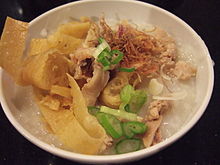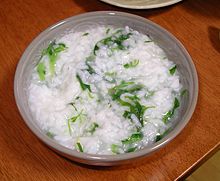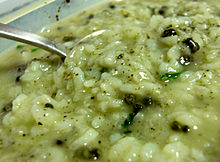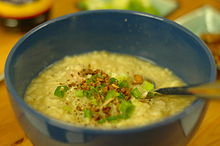- Congee
-
Congee 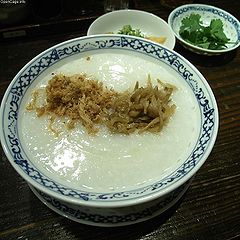
Chinese rice congee with rousong and zha cai (coriander in side bowl) Chinese name Chinese 粥 Transcriptions Hakka - Romanization zuk5 (IPA: [tsūk]) Mandarin - Hanyu Pinyin zhōu Wu - Shanghainese
romanizationtzoq (IPA: [tsɔ́ʔ]) Cantonese (Yue) - Jyutping zuk1 - IPA [tsʊ́k] - Taishanese Jyutping zuk1 (IPA: [tsūk]) Min Chinese name Chinese 糜 Transcriptions Min - Hokkien POJ môai/mê/bôe/bê (IPA: [tʃók]) Japanese name Kanji 1. 粥
2. 白粥Hiragana 1. かゆ
2. しらがゆTranscriptions - Revised Hepburn 1. kayu
2. shiragayuKorean name Hangul 죽 Hanja 粥 Transcriptions - Revised
Romanizationjuk - McCune-
Reischauerchuk Malay name Malay bubur Portuguese name Portuguese canja Thai name Thai โจ๊ก chok Vietnamese name Vietnamese cháo Spanish name Spanish arroz caldo Khmer name Khmer បបរ bâbâr ([bɑˈbɑː]) Indonesian name Indonesian bubur Javanese name Javanese bubur Bengali name Bengali জাউ jau (IPA: [dʒaw]) Burmese name Burmese ဆန်ပြုတ် san byohk Hindi name Hindi गांजी ganji Malayalam name Malayalam കഞ്ഞി kanji Tagalog name Tagalog lugaw Tamil name Tamil kanji=கஞ்சி Telugu name Telugu ganji=గంజి Congee is a type of rice porridge popular in many Asian countries. It can be eaten alone or served with a side dish. Names for congee are as varied as the style of its preparation. Despite its many variations, it is always a thick porridge or soup of rice which has usually disintegrated after prolonged cooking in copious water.
To prepare the dish, rice is boiled in large amounts of water until it softens significantly. Congee can be made in a pot or in a rice cooker. Some rice cookers have a "congee" setting, allowing it to be cooked overnight. The rice used can either be sticky or regular depending on the country's common practice. Culture also often dictates the way congee is cooked and eaten.
In other Asian cultures, it is also called kanji (Tamil/Malayalam/Tulu), ganji (Kannada/Telugu), juk (Cantonese, Korean), cháo (Vietnamese), chok (Thai), kayu (Japanese), lúgaw (Filipino), or jaou (Bengali) which is derived directly from the Chinese character zhou (粥, which means gruel in Mandarin). Zhou is also called xifan in some Chinese provinces.
In some cultures, congee is eaten primarily as a breakfast food or late supper; in others, it is eaten as a substitute for rice at other meals.[citation needed] It is often considered particularly suitable for the sick as a mild, easily digestible food.
Contents
Bangladesh
In Bangladesh, congee, known as konji jaou or kanji jaou (which comes directly from the Chinese character zhōu or gruel), along with panta bhat, is popular throughout the whole country, more so in rural areas than urban. It is made by repeatedly boiling rice in large quantities of water. The result is a thick white broth. Its consistency and colour are dictated by the water-to-rice ratio (which can be from 5:1 to 13:1) and the various types of rice used. Glutinous rice is often used in Sylhet and Khulna, which makes the broth quite distinct from other types in the country.[citation needed] In some parts of the country, it is smoked while cooking, giving it a unique aroma. It is usually served for breakfast with lime, salt, chilli and fried shallot. On its own, it is fed to the unwell as it is believed to be beneficial to the digestive system.[citation needed]
Burma
In Burma, rice congee is called san byohk: literally "rice boiled". It is very thin and plain, often made with just rice and water, but sometimes with chicken or pork stock and served with a simple garnish of chopped spring onions and crispy fried onions. As in other Asian countries, san byohk is considered lu ma mar zar ("food for the unwell").[citation needed]
Cambodia
In Cambodia, rice congee (babaw) is widely eaten for breakfast. Plain congee is typically eaten with salted eggs, pickled vegetables, or dried fish. Chicken congee, pig's blood congee, and seafood congee are also commonly eaten.[citation needed]
China
There are many regional variations of Chinese congees (Chinese: 粥; pinyin: zhōu). For example, to make Cantonese congee, white rice is boiled in many times its weight of water for a long time until the rice breaks down and becomes a fairly thick, white porridge (Pinyin: báizhōu).[1] Congees made in other regions may use different types of rice with different quantities of water, producing congees of different consistencies.
Congee is often eaten with zhacai, salted duck eggs, lettuce and dace (Cirrhinus chinensis) paste, bamboo shoots, youtiao, rousong, pickled tofu, wheat gluten, with other condiments, meat or century eggs.
Other seasonings, such as white pepper and soy sauce, may be added. Grilled fish may be mixed in to provide a different texture.
Congee is often eaten with fried bread sticks known as youtiao. Congee with youtiao is commonly eaten as breakfast in many areas in China. Congee can be left watery, or can be drained so it has a texture similar to Western oatmeal porridge. Congee can also be made from brown rice, although this is less common and takes longer to cook.
Besides being an everyday meal, congee is considered to be food therapy for the unwell. Ingredients can be determined by their supposed therapeutic value as well as flavor.
The origin of congee is unknown, but from many historical accounts, it was usually served during times of famine, or when numerous patrons visited the temples,[citation needed] as a way to stretch the rice supply to feed more people.
In China, congee has also been used to feed young infants. However, the cooking time is much longer than for okayu and, because it is for infants, the congee is not seasoned with salt or any other flavoring. Often it is mixed with steamed and deboned fish.
Congee made from other grains, such as cornmeal, millet, barley, and sorghum, are common in the north of China[citation needed] where rice does not grow as well as other grains suited for a colder climate. Multigrain congee mixes are sold in the health food sections of Chinese supermarkets. Congee with mung beans is usually eaten with sugar, like red bean congee.
India
In Tamil Nadu, a plain rice porridge, or the thick supernatant water from overcooked rice, is known as kanji. The people of Kerala also call this preparation of rice in a watery state kanji, and it is eaten as a porridge with green lentils or chutney.[citation needed]
In the Goa, Udupi and Mangalore districts, people usually eat rice ganji in a variant manner made by Kannada-speaking, Tulu-speaking or Konkani people in and around Udupi and Mangalore (Karnataka, South India). Here, parboiled rice (kocheel akki in Kannada, oorpel aari black rice bulenta aari white rice in Tulu or ukadey tandool in Konkani) is steamed with a large amount of water. Jain ganji matt are famous in these districts. Usually simple ganji with pickle and milk are served, in Jain matts. Fresh coconut is grated, and the resulting milk skimmed and added to the ganji (called pej in Konkani), which is served hot with fish curry, coconut chutney, or Indian pickles. In Goa, it is normally served with dried or fresh cooked fish, papad or vegetables.[citation needed]
In the state of Andhra Pradesh, it is called ganji in Telugu and mostly eaten by the very poor.[citation needed]
“Kanji”. Kanji is an authentic and traditional Oriya dish. People in Orissa like it because of its unique taste. It is a soup based dish like Dal but tastes little sour. This is a very healthy dish as lots of vegetables and curd are used as main ingredients.[citation needed]
Indonesia
In Indonesia, congee, called bubur, is a favourite breakfast food, and many food vendors pass through the streets at dawn, calling "bubur" to sell it to householders. A popular version is bubur ayam, which is congee with shredded chicken meat. It is also served with many condiments, such as green onion, crispy fried shallot, fried soybean, Chinese crullers (youtiao, known as cakwe in Indonesia), both salty and sweet soy sauce, and sometimes it is topped with yellow chicken broth and kerupuk (Indonesian style crackers). Unlike many other Indonesian dishes, it is not spicy; sambal or chili paste is served separately.
The food hawkers sometimes have sate to go with it, made from quail egg or chicken intestine, liver, gizzard, or heart.
In another region of Indonesia, Manado, it is very popular with Tinutuan or bubur Manado (Manadonese porridge), another porridge with ample vegetables. A bit different from the one sold in Java Island, it is made from rice porridge and enhanced with water spinach or kangkung, corn kernels, yam or sweet potato, dried salty fish, lemon basil or kemangi leaves, and melinjo or gnetum gnemon leaves.
Sago flour is made into porridge in eastern Indonesian, as the staple food of Maluku and Papuan people. The sago congee is called papeda, and usually is eaten with yellow soup made from tuna or mubara fish spiced with turmeric and lime.
Japan
Okayu (お粥) is the name for the type of congee eaten in Japan,[2] which is considerably thicker than congee produced in other cultures.[citation needed] For example, a Cantonese-style congee typically uses a water-to-rice ratio of 12:1, but okayu typically uses ratios of 5:1 (zen-gayu) or 7:1 (shichibu-gayu).[citation needed] Also, its cooking time is shorter than other types of congee: okayu is cooked for about 30 minutes, while Cantonese congees cook for an hour or more.
Okayu may be made with just rice and water, and is often seasoned with salt. Beaten eggs could be beaten into it to thicken it into gruel. Toppings may be added to enhance flavour; negi (a type of green onion), salmon, roe, ginger, and umeboshi (pickled ume fruit) are among the most common. Miso or chicken stock may be used to flavor the broth. Most Japanese electric rice cookers have a setting for okayu.
In Japan, okayu is popularly known as a food served to the ill.[3] Because it is soft and easily digestible, okayu is the first solid food served to Japanese infants; it is used to help with the transition from liquids to the thicker rice dishes which constitute much of the Japanese diet.[citation needed] It is also commonly eaten by the elderly for the same reasons.
A type of okayu called nanakusa-gayu (七草粥, "seven herb porridge") is traditionally eaten on 7 January[4] with special herbs that some believe protect against evils and invite good luck and longevity in the new year. As a simple, light dish, nanakusagayu serves as a break from the many heavy dishes eaten over the Japanese New Year.
Zōsui (雑炊) is a similar dish, which uses already cooked rice, rather than cooking the rice in the soup.
Korea
See also: Juk.In Korea, the dish goes by the name juk 죽 ([tɕuk]) derived from the Chinese language in which juk [jook] means the same thing. There are more than forty varieties of juk mentioned in old documents.[5] Depending on the ingredients and consistency, juk can be considered as a food for recuperation (much like chicken soup in modern American culture), a delicacy, or food during famine and war.[5]
The most general form of juk is simply called heen juk (흰죽, white juk), which is made from plain white rice. Other varieties include different ingredients, such as milk, vegetables, seafood, nuts and other grains. Being largely unflavored, it is served with a number of more flavorful side dishes, such as jeotgal, various types of kimchi, pickled cuttlefish, spicy octopus, and other side dishes.
Notable varieties include jatjuk made from finely-ground pine nuts, jeonbokjuk made with abalones, yulmujuk made from Job's tears, and patjuk made from red beans.
Juk is considered the ideal choice of food for babies,[6] the ill or elderly as it is easily eaten and digested. It is sold commercially by many chain stores in South Korea, and is a common takeout dish.[7]
Philippines
Lúgaw (alternately spelled lugao or lugau) is the Filipino name for congee. Otherwise similar to Cantonese-style congee, lúgaw is typically thicker, retaining the shape of the rice, but with a similar texture. It is boiled with strips of fresh ginger. Other flavors may be added according to taste. Most often it is topped with scallions and served with crispy fried garlic. As with Japanese okayu, fish or chicken stock may be used to flavor the broth. Lúgaw can also be served with tokwa't baboy (diced tofu and pork), goto (beef tripe), utak (brain [of pig]), dilâ (tongue [of pig]), litid ([beef] ligaments), and with calamansi, patís, and soy sauce. It is often served to the ill and the elderly, and is favoured among Filipinos living abroad in colder climates because it is warm, soft, and easily digestible.
Some provinces prefer the Spanish-influenced arroz caldo (literally "rice broth"), which is often thought to be a European dish because of its name. Arroz caldo is actually a Chinese congee that was adapted to the tastes of the Spanish colonial settlers who patronised Chinese restaurants in the Philippines.
Arroz caldo is usually spiced with safflower and black pepper in place of or in addition to the more traditional ginger and scallion. Arroz caldo more closely resembles risotto than congee, from which it can be distinguished by its bright yellow saffron colour and the relatively larger pieces of chicken meat. Arroz caldo is more popular among people of Ilokano heritage, although those of other provinces, such as Cebu, often eat it with the addition of prawns, olive oil, bay leaf, and Chinese sausage.
Portugal
In Portugal, a traditional soup made of rice and chicken meat is named canja. The rice is not cooked for as long as in Asian congee, so it is very soft, but not disintegrated. Traditionally, a boiling fowl containing small, immature eggs is used; the eggs are carefully boiled and served in the canja. This soup is sometimes served with a fresh mint leaf on top. Canja is traditionally given to people recovering from disease, as in Asia, and is strongly valued as comfort food. In some regions of Portugal, there is even an ancient custom of feeding the mother a strict diet of canja in the first weeks after childbirth. It is also eaten traditionally in Brasil and Cabo Verde, formerly Portuguese colonies.
Sri Lanka
In Sri Lanka, rice congee is known as kola kanda in Sinhalese, and tends to have various local indigenous herbs and plants mixed in with it. It is traditionally eaten for breakfast, and consists of rice, water and local herbs (gotu kola). It is also eaten by Sri Lankan Muslims for iftar during Ramadan. It is also occasionally made with oats. Tamils and Muslims in Sri Lanka call it aarisi kanji (rice kanji) and use chicken or beef for it. It is sometimes made with milk (paal kanji), and there are many other combinations with appropriate prefixes in Tamil.
Taiwan
In Taiwan, congee is prepared in the same way as in Fujian Province, China, and consists of rice and water, with few other ingredients. Sweet potato is often added for taste, and eggs are sometimes beaten into it to thicken it to a gruel. As with most Chinese styles, congee is often served to the ill and those with difficulty chewing. A variety of side dishes are often served with congee as well.
Thailand
In Thai cuisine, rice congee, known as chok (Thai: โจ๊ก, IPA: [tɕóːk], a loanword from the Min nan Chinese languages), is often served as breakfast with a raw or partially-cooked egg added. Minced pork or beef and chopped spring onions are usually added, and the dish is optionally topped with a small version of youtiao (called pathongko in Thai), fried garlic, slivered ginger, and spicy pickles such as pickled radish. Although it is more popular as a breakfast dish, many stores specializing in congee sell it throughout the day. Variations in the meat and toppings are also frequently found. It is especially popular during Thailand's cool season.
Plain rice congee, known as khao tom kui (Thai: ข้าวต้มกุ๊ย) in Thailand, is often eaten at specialized restaurants which serve a multitude of side dishes to go with it such as yam kun chiang (a Thai salad made with sliced dried Chinese sausages), mu phalo (pork stewed in soy sauce and five-spice powder), and mu nam liap (minced pork fried with chopped Chinese olives).
Vietnam
In Vietnam, rice congee, called cháo, is sometimes cooked with pandan leaves or Asian green beans. In its simplest form (plain rice porridge) it is a food for times of famine and hardship, when rice is not abundant. Or, as is especially common among Buddhist monks, nuns and lay people, it can be a simple breakfast food eaten with pickled vegetables or fermented tofu. Despite its humble ubiquity among the poor, it is also popular as a main entrée when cooked with a variety of meats. For example, cháo gà is a variety of cháo cooked with chicken, garlic, and ginger. The rice porridge is cooked in the broth in which a whole chicken had been boiled, and once the chicken is cooked, the meat is sliced and layered on a bed of shredded, uncooked cabbage, sliced onions, and drizzled with a vinegar-based sauce, to be eaten as a side dish to the porridge. Other combinations include cháo vịt (duck porridge), which is cooked in the same fashion as the chicken porridge, but with duck. Cháo lòng heo is made with lòng heo (a variety of pork entrails, including sliced cakes of congealed pork blood). It is also common to eat cháo during an illness, as it is believed the porridge is easy to digest while being fortifying. For such purposes, the cháo is sometimes cooked with roasted white rice, giving the porridge broth a more nuanced body and a subtle, nutty flavor. On a related note, in some parts of Vietnam, local customs call for making cháo for death anniversary ceremonies, during which it is offered to fortify the spirits of the dead. (This tradition, however, is not widely practiced and seems to contradict the general principle of providing only the best food for one's ancestors.)
See also
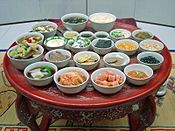
This article is part of a series on Korean cuisine
한국 요리StaplesBap • Juk (mieum) • Guksu • Mandu • Kimchi bokkeumbap
AncillariesBeveragesOtherKimchi Field Museum • Kimchi refrigerator • List of Korean dishes • List of Korean beverages • Korean royal court cuisine Korea portal
Korea portal- Bengali cuisine
- Filipino cuisine
- Gruel
- Japanese cuisine
- Red bean soup
- Rice pudding
- Sago pudding
- Tamil cuisine
- Tapioca pudding
- Thayir sadam
- Udupi cuisine
References
- ^ "Basic Congee Recipe". about.com. http://chinesefood.about.com/od/breakfast/r/congee.htm. Retrieved May 2, 2007.
- ^ "Okayu recipe". about.com.
- ^ http://books.google.co.jp/books?id=21251aZNevcC&pg=PA57&dq=okayu+japan+sick+ill&hl=en&ei=TnE6TafcN4OuuQOq6djkCg&sa=X&oi=book_result&ct=result&resnum=7&ved=0CEUQ6AEwBg#v=onepage&q&f=false
- ^ http://books.google.co.jp/books?id=u1OMoSSSEkQC&pg=PT206&dq=nanakusagayu&hl=en&ei=f3A6TdDnLovUvQPRp4WJCg&sa=X&oi=book_result&ct=result&resnum=2&ved=0CCgQ6AEwAQ#v=onepage&q&f=false
- ^ a b (Korean) "Juk". Doosan Encyclopedia. http://100.naver.com/100.nhn?docid=140915.
- ^ (Korean) "Food industry eyes baby market". Newsis Health. March 30, 2010. http://media.daum.net/society/welfare/view.html?cateid=1066&newsid=20100330101211929&p=newsis.
- ^ (Korean) "Busy juk restaurants". City News. May 17, 2010. http://www.clubcity.kr/news/articleView.html?idxno=57572.
Philippine cuisine Individual dishes Desserts - See also: List of Philippine dishes
- Philippine condiments
- Kapampangan cuisine
- List of Philippine restaurant chains
Categories:- Rice dishes
- Porridges
- Chinese cuisine
- Indian rice dishes
- Japanese cuisine
- Korean cuisine
- Philippine cuisine
- Taiwanese cuisine
- Tamil cuisine
- Vietnamese cuisine
- Breakfast foods
Wikimedia Foundation. 2010.

